Normalizing by peaks is not a good idea, and won't give you files with a similar average volume... especially since several of the tracks have the needledrop at the beginning, which is the highest peak for the track. ReplayGain is the way to go, otherwise you have to change the level of the files, lowering the hottest ones and raising the quietest ones, til they all have about the same RMS level.
Primary tabs
Nine Cartridge Survey Produces Audible Results?

Each was recorded using one of ten different cartridges, nine of which were mounted on a VPI Traveler connected to a Graham Slee Era Gold Mk. V MM phono preamp.
The tenth is Ortofon’s $8499 Anna, which was mounted on the Continuum Cobra tonearm, Caliburn turntable combo connected to a Ypsilon MC-16 step transformer and VPS-100 phono preamp. That file is the “control” against which the others should be compared, except it will not be identified as such. None of the files, all created using a moderately priced HRT LineStreamer+ analog to digital converter, will be identified.
If you so choose, you can download the FLAC files and using a USB DAC, play them through your audio system. This will enable you to compare each cartridge’s rendering of the same song and your judgments without knowing which was which. Should you choose, you can vote for your favorite and in addition, in the comment section, we welcome your top three or top five favorites.
Listed from least expensive to most expensive, the nine moderately prices cartridges are:
Audio-Technica AT95E ($40)
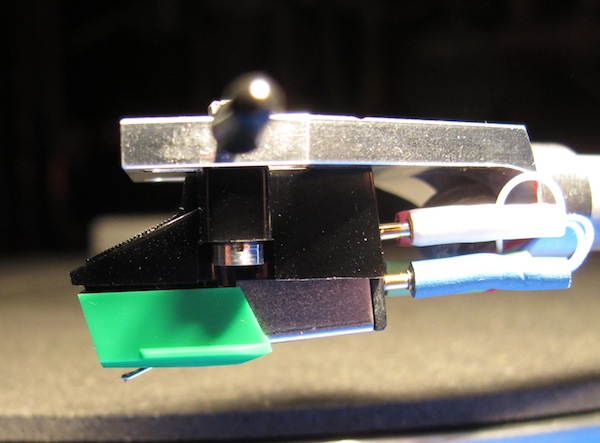
Audio-Technica AT95SA ($149.95)

Audio-Technica AT7V ($159.99)

Grado Gold 1 ($220)
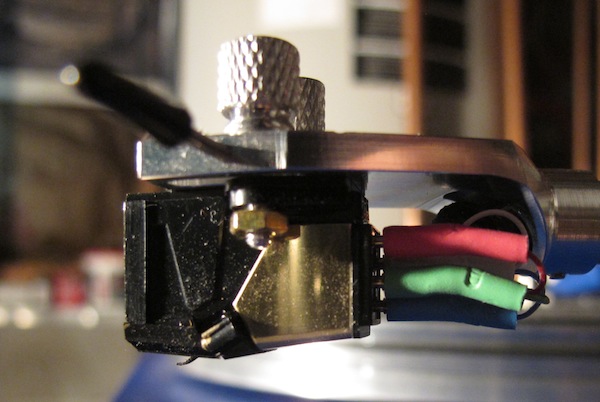
Ortofon 2M Bronze ($419)

Nagaoka MP-300 ($499)
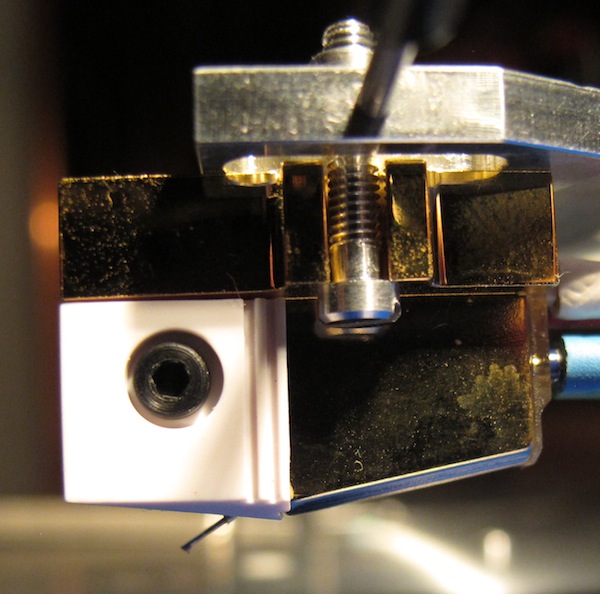
Sumiko Blue Point EVO III ($499)
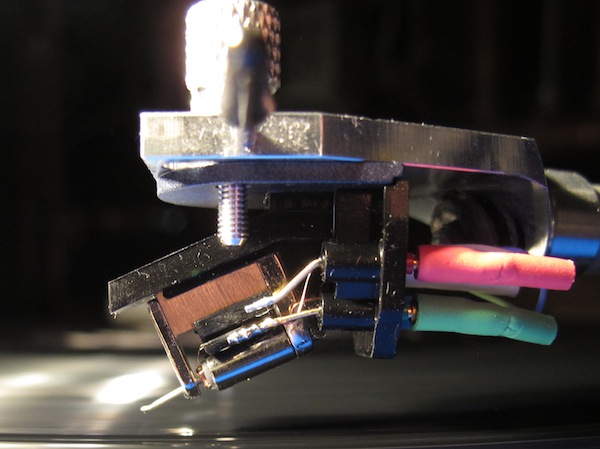
Ortofon 2M Black ($719)
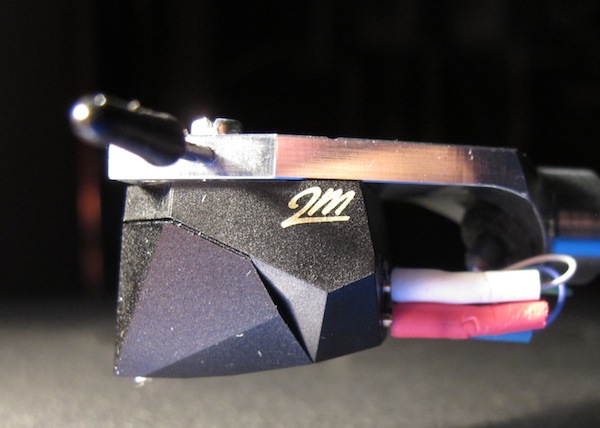
Audio-Technica AT150ANV ($999)

All are moving magnet designs, with the exception of the Grado Gold 1, which is a moving iron and the Sumiko Blue Point EVO III, which is high output moving coil design.
While the cartridges are listed above in order of price, the files are not! The are organized randomly. Right click on PC or Control click on a Mac to download to your desktop.
Download Cartridge Test File #1 (68.8 MB)
Download Cartridge Test File #2 (73.7 MB)
Download Cartridge Test File #3 (71.8 MB)
Download Cartridge Test File #4 (77.7 MB)
Download Cartridge Test File #5 (71 MB)
Download Cartridge Test File #6 (73.7 MB)
Download Cartridge Test File #7 (74.5 MB)
Download Cartridge Test File #8 (71 MB)
Download Cartridge Test File #9 (75.6 MB)
Download Cartridge Test File #10 (71.6 MB)
In a few weeks we will reveal their identities. In addition, because I’m sure some if not many of you will not take the time to download and listen, I will review each from my perspective and include the specs (etc.).
In addition, if you like the track (I didn’t get sick of it and I listened dozens of times), HDTracks has generously given us a discount download code if you are so digitally inclined. Also note that the album is available on CD and SACD as well as on vinyl.
Special HDTracks.com offer: Now through August 31st receive a 20% download discount on Myra Taylor's "My Night To Dream". Choose either the 88.2/24 bit or the 44.1k/16 bit version or both. Use promo code "compare20"
Choose your favorite sounding Cartridge Test File below:

- Log in or register to post comments


Even looking at the file sizes you could postulate that test file #4 is the high output cart because the louder the music the higher the file size. The smallest file size test #1 could be cart that is the lowest output.

----------------------------------------------------------------------------------------------
Analyzed folder: /Users/Icarus/Downloads/Fremer Cartidge Test Files/Wave
----------------------------------------------------------------------------------------------
DR Peak RMS Filename
----------------------------------------------------------------------------------------------
DR13 -2.23 dB -19.67 dB 01 Unknown Title.wav
DR12 over -15.09 dB 02 Unknown Title.wav
DR13 -1.07 dB -16.97 dB 03 Unknown Title.wav
DR13 -1.18 dB -17.39 dB 04 Unknown Title.wav
DR13 -2.57 dB -20.34 dB 05 Unknown Title.wav
DR13 -2.69 dB -20.59 dB 06 Unknown Title.wav
DR13 -1.28 dB -17.38 dB 07 Unknown Title.wav
DR13 -2.23 dB -18.62 dB 08 Unknown Title.wav
DR11 over -13.73 dB 09 Unknown Title.wav
DR13 -1.42 dB -17.43 dB 10 Unknown Title.wav
----------------------------------------------------------------------------------------------
Number of files: 10
Official DR value: DR13
==============================================================================================

If I was a betting man I would say number 4 is your control. That is the only track that has power and transients that reach up to 48kHz. Tracks 5, 6, and 7 also have power and transients that exceed 30kHz. I am not even going to comment on the clipped tracks 2 & 9.
My favorite track 4 its it detailed, sibilents sound airy/dry, the drums are very clean, and the bass sounds natural. It is bright obviously and my second favorite is a tie between 5 & 7 which has the detail of 4 and the warmness of 5.

First impressions while listening to them on the MacBook Pro laptop speakers:
The most "underwhelming" presentation would appear to be that of cartridgetest_4. I would reckon that it is the recording from the Ortofon Anna. It just does everything right and, as a result, draws no attention to anything in particular (either standing out, or missing). Disclaimer: I have a slight advantage of living with the A-90 on an SME 20, and the family resemblance is hard to miss.
Speaking of the "Ortofon sound" or lack thereof, I would hazard a guess that cartridgetest_6 is a recording of the Ortofon Black. I'll have to listen again with a set of 'phones or on a rig to pin down the Bronze and possibly the Nagaoka. Can't say I would bet the farm on identifying the Grado or Sumiko, but I may have a crack at it just for kicks.

Listened with a Schiit Magni/Modi and Shure SRH1840. I would say 7, 6, and 4 are my three favorites and 6 is my all around favorite. The treble on 7 is a little hot but the detail is fantastic.
5, 3, and 1 sound great too.
All 6 of these are fantastic and I would be content with any of them on my TT. I think the cheapest out of these 6 is the winner here!
I hope the Grado Gold1 gets a lot of votes, that's what I have on my TT now!

So I was pretty stoked to try out the files. Bought a decent budget DAC (DacMagic 100), and hooked up the MacBook Pro. Was really impressed with what I heard. Couldn't help but order the vinyl from AcousticSounds. Anxiously cued it up....and realized I either have some major setup flaw, or perhaps my TT/cartridge just isn't up to the challenge. PISSED!!! Am I out-of-line in thinking that a Music Hall MMF-7 with the stock Goldring EroicaH fed through a Sutherland P.H.D. should be able to put up at least a comparable soundstage? It's not even close to the worst of the digital recordings in terms of soundstage. My rig's soundstage just muddles everyone/thing in the center in comparison. Very little seperation of insturments, and vocals. I am seriously frustrated. Not long ago I though I had everything dialed in pretty well using the HiFi News Test LP, but apparently not.
Bitching aside... I really did enjoy listening to the samples, and am anxious to see the results. I'll have to do a little more listening before casting my vote.
In the meantime, any suggestions would be appreciated.

Well, I would get rid of the Eroica instantly, and go for something like a Dynavector 10X5 or the XX2H, both hi-output.
I had one Eroica some time ago, and thought of it as a weird sounding and kind of crapppy cartridge - I completely dislike it.
Other factor might be the setup. A well done turntable setup is like getting together the best ingredients and the best chef.

Ditto on that, the MMF-7 is a nice sounding table but the Eroica, not so much. I actually liked the Goldring 1012,1022,1042 on that over the Eroica. The Grado Platinum and Sonata also sound great on the MMF7.

That Mr. Fremers setup is probably close to $200,000 and yours about 1% the value of that right? You will hear pretty big differences between yours and his.
Now, it is possible that you don't have your system perfectly setup which could possibly make a difference as well.

...for this comparo he used a VPI Traveler turntable, and a Graham Audio phono preamp. I'd say that the tables are relatively comparable, but will admit that the VPI probably holds an advantage. However I'd have to argue that my phono pre is a step above the one used here.
I'm going to really try hard to dial in my setup this next week, and hope I can resolve this. Guessing the issue may stem from a less than perfect azimuth setting. Should have an oscilloscope by then to help nail down proper azimuth. Fingers crossed! But to be honest, I have a feeling this is going to lead to a new table/arm purchase.

I'm not going to let the cat out of the bag but if you own #6 or one of it's family mates, you probably know what it is. I own this record (thanks Mikey!) and I heard the same trait. Can't wait to find out if I'm right!

For anyone who's inerested, here's a link for versions with the volumes adjusted (RMS) and start times aligned (24/96 WAV).
It will make these comparisons much easier and accurate.

Files are downloaded and queued for listening ... (waiting on a new optical cable between my computer and DAC)
What did you use to make the adjustments and conversions? I'm new to this and am appreciative of your effort, just curious on my part.

Longtime reader, first time poster.
I LOVE doing A/B comparisons, and I smiled as I was downloading/prepping for this throwdown.
I normalized all the files to -0.5db (and cut a few of the tracks' pop from dropping the needle at the beginning of the tracks, which would throw off the normalization).
Used a pair of ATH-W1000x's, which I love for it's AudioTechnica sound (I am running a AT-150MLX right now; great match).
Here are my ideas I sketched out when listening and then A/B'ing:
1: Not much to say; decent surface noise. Did not grab my attention.
2: loses the guitar on the right channel; squashed soundstage.
3: ** Open/ natural. laidback. good, but not great surface noise.
4: loud! (this is all I wrote about it; did not find it grabbing my attention)
5: huuummmmm -- is this the Grado? -- good surface noise. not great.
6: low output / MC sound. Good surface noise, but less bite. FLAT.
7: *** grabs attention. great attack; dead silent surface noise; my 2nd favorite!
8: bad. uninvolving. cheap, lack of soundstage. flat, one dimensional. AT95e?
9: bad surface noise. nothing else to say that grabbed attention.
10: ***** MY FAVORITE: sharp, bright, great dead-silent surface noise. Wonderful detail and realism. Is this the high-end AudioTechnica?
(I am very concerned with surface noise, because I grew up entirely with CDs and have spent years purging noise from my vinyl setup. I have found that with AT's shibata styli!)

I have a class-"C" system and a 40-year-old turntable, but I'm going to add my two cents anyway, just so it's on record when I see the results.
1. Snap, layered, rich, listenable
2. Forward, blatty, lots of reverb
3. Flat
4. Smooth
5. Nice reverb, momentum, grabs my heart.
6. Flat, dull, boring (I hope this is not my Grado)
7. Nice. Jump! Separation.
8. Bass, lots of reverb, weak horns/voice
9. Loud, dry
10 Forward, no bass, makes me sad.
My faves are 5 and 7, least favorites are 3 and 10.

The fact that none of these are absolutely better than any other can't be good news for Continuum or Ortofon.

Mr. Fremer, I'm curious about the legality of posting this music clip? Did you ask permission before uploading? I only ask because I want to post comparison clips like this on my own audio blog and want to know the legal ins-and-outs of doing so.

Some folks didn't read the intro to this where Mikey explains he has permission to use the clip. Don't know why so few picked it, but 3 has a lot of detail the others lack...it's just not as loud and boasty in the high end. VERY interested to see what the actual carts used are.


Since track #5 is the only one that audibly mistracks at the :40 mark, I rather doubt that's the 100k rig.
To me and my ears, the Continuum is clearly #1.

As kurb1980 shows in his posting you are over 0 dBfs on cartridgetest_2 and cartridge_test_9.
So those two are disqualified for me right away. Running out of bits is a big "no-no" when recording digitally! Yes it would be nice to get them all recorded at equal levels but if I take the time to fiddle with the files I can normalize with software. However it occurs to me that someone else has probably already done all this. If so please post them so I don't have to bother with it. Once I noticed how bad track 2 sounded in comparison to track 1 I kinda lost interest already but maybe I will come back to it and compare the remaining 8 to each other.
It's a cool idea but unfortunately you need to be a little more meticulous next time with your recording levels.

Interestingly when I play the tracks through Pure Music to check the dynamic range I get much better numbers than kurb1980 posted from whatever software he used. Tracks 1 and 10 measured 20 on Pure Music's Dynamic Range Meter. Anybody know the reason for the difference? A 7 dB difference in dynamic range is huge.
Sorry if I was terse in my previous posting. I'm sick today so not at my best. You clearly put a lot of work into this project.

Track 5 is apparently a full one second slower. Could theTraveller spin a little faster than the Caliburn?

...that the pressing that I JUST received is not as good as the copy these samples were taken from? Kinda curious seeing as I'm considering spending in the neighborhood of $4-5k because of these damn digital recordings.
You know what Fremer?!?!? As much as I like reading your write-ups, sometimes you're just a pain in my ass/wallet. ;-)

Thanks for creating this survey. It was a lot of fun. Much effort is required, however, would love to participate in more of these. Wonder if the conditions of this survey would satisfy the double blind testing brigade :-)
My rankings from most preferred (#9) to least preferred (#5) and their associated polarities non-inverted (NI), inverted (I)
1. #9 NI
2. #7 NI
3. #2 NI
4. #10 I
5. #3 NI
6. #1 NI
7. #8 I
8. #6 I
9. #4 NI
10. #5 NI
Evaluations were carried out using
- Audacious audio player (http://www.audacious-media-player.org) on debian Linux.
- Steve Harris's LADSPA plugins (http://plugin.org.uk) was used to invert polarity in the digital domain.
- external USB DAC Destroyer using Burr-Brown 2705 chip
- Koss TD/65 headphones
The source recording had tracks with mixed polarity. eg. the piano and brass/trumpet section was inverted with respect to the other instruments.

The absolute polarity of the files is all the same... I didn't check every single one, but just looked at a few you said were inverted, and one not, and they are the same. You can see it clearly by looking at the waveforms in this screenshot, noticing the peaks and dips in the waveforms are the same. http://oi44.tinypic.com/2uynnzn.jpg

Treated this as a listening test. All the results shown were determined by listening. The ratings were decided using the associated polarities shown. ie. polarity that sounded better to me. Thanks for a visual confirmation that cartridges # 3,4 and 7 seem to have the same polarity.

Just realised there may have been a misunderstanding with my rankings, For example, the first line
1. #9 NI
means that I rank cartridge file #9 first/highest/best without polarity inversion. Not, that I rank the first cartridge ninth without polarity inversion. ie. the hash # indicates the cartridge file, not the rank. Sorry for the confusion.






















































